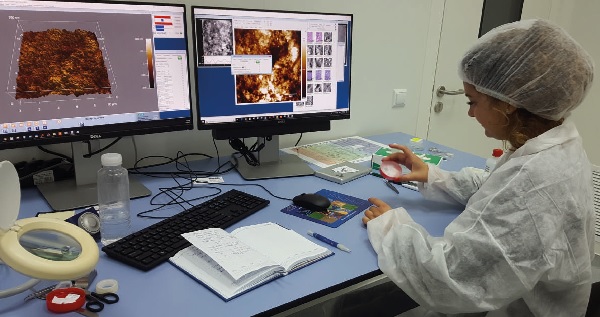Analysis and characterization
Modern analytical and characterization techniques are used to enable detailed study of solid, liquid or gaseous samples. The methods used have high sensitivity and selectivity and provide information on composition and structure as well as properties.

Solid state NMR spectroscopy
Researcher: Xenia Filip
Solid State Nuclear Magnetic Resonance Spectroscopy (ss-NMR) is an analytical technique for characterization of organic or inorganic materials, the signal being generated by atomic species with non-zero nuclear magnetic moment. The nuclei most frequently studied inthe case of organic compounds are 13C, 15N, 1H

Liquid NMR spectroscopy
Researcher: Adrian Pîrnău
Nuclear Magnetic Resonance Spectroscopy on liquid samples is an analytical technique for the characterization of molecular and biomolecular systems with which information about structure, dynamics and intermolecular interactions is obtained. NMR spectroscopy involves the quantum magnetic properties of atomic nuclei. These properties are influenced by the molecular neighborhood, and their measurement provides a map of interatomic bonds…

ESR spectroscopy
Researchers: Adriana Paula Popa, Dana Toloman
Electron Spin Resonance Spectroscopy (ESR) is an analytical technique for analyzing organic or inorganic materials, the signal being generated by unpaired electronic species. The ESR spectrum is obtained by sweeping a magnetic field while the sample is subjected to a microwave field of given frequency.

Liquid chromatography
Researcher: Maria-Loredana Soran
Liquid chromatography is a laboratory technique that separates chemicals in a mixture, allowing their qualitative and quantitative determination. It is based on the different distribution of the components of a mixture between two phases: the stationary phase and the mobile phase. Liquid chromatography can be closed column or open column…

Inductively coupled plasma mass spectrometry
Researcher: Cezara Voica
Inductively Coupled Plasma Mass Spectrometry (ICP-MS) is a highly sensitive and selective analytical technique used for elemental determinations. It is based on the separation, identification, and quantification of a sample’s components in relation to their mass. ICP-MS has superior advantages over other analytical techniques…

Porosity characterization of solid materials
Researcher: Diana Lazăr
The determination of the porosity parameters of solid materials – surface area, pore volume and pore size – is carried out using isothemal adsorption/desorption of nitrogen molecules on the solid surface technique. The advantages of this method are: high versatility – it is possible to measure the surface of any solid with an area higher than…

X-ray diffraction
Researcher: Maria Olimpia Miclăuș
X-ray diffraction is an analytical technique used for characterizing solid materials, whether organic or inorganic, with diffraction intensities generated as a result of the interactions between X-rays and the electrons of the atoms in the lattice. Depending on the behavior of the compounds we want to investigate, we use either powder diffraction or single crystal diffraction…

Atomic force microscopy
Researcher: Diana Bogdan
Atomic Force Microscopy (AFM) is part of the Scanning Probe Microscopy (SPM) family of techniques for the investigation of surfaces by scanning with a very sharp tip. The AFM image is obtained by monitoring the position of a probe (scanning probe) attached to a microcantilever as it scans the sample surface. The AFM topography has nanometer resolution…

Characterization of the active surface of catalysts
Researcher: Maria Miheț
Investigation of the interaction of reactant molecules with catalyst surfaces is of vital importance in the design and efficiency of any catalyst or catalytic process. One of the most widely used techniques in this respect is the study of surface interactions under programmed temperature conditions. The advantages of this method are…

Ultrasound-assisted extraction of organic compounds
Researcher: Maria-Loredana Soran
INCDTIM’s concerns for the extraction of organic compounds from different matrices led to the selection and adaptation in our laboratory of a large number of techniques. Experimental results obtained, over the years, by the Multifunctional Materials and Biologically Active Compounds research team have led to the conclusion that ultrasound-assisted extraction…

Photopiroelectric calorimetry
Researchers: Dorin Nicolae Dădârlat, Carmen Tripon
Photopyroelectric calorimetry is a highly accurate technique which provides a complete thermal characterization (determination of all thermal parameters) of any chemically non-aggressive material in condensed phase (solid or liquid). The technique can also be used in the study of physical and chemical processes associated with the variation of thermal parameters…

Detection and monitoring of pesticide residues
Researcher: Florina Dorina Covaciu
“A residue is a minute amount of active substance from a pesticide that may remain in a treated crop“, according to the European Food Safety Authority (EFSA). Consequently, the European Commission has established Maximum Residue Levels (MRLs) to ensure consumer protection against unacceptable levels of pesticide residues. The development of analytical techniques is increasingly focused on the precis detection of molecules present in infinitesimal quantities…

Ultra-high vacuum scanning probe microscopy by STM and AFM
Researcher: Daniel Marconi
Scanning probe microscopy, AFM and STM, is a technique for mapping at the nanoscale the physico-chemical surface properties of a material, such as relief, electrical conductivity, elastic modulus, magnetization, chemical composition, thus obtaining a picture of how these properties are distributed on the surface of the sample under study. Depending on the physical or chemical properties being mapped, scanning probe microscopy can be of several types…
